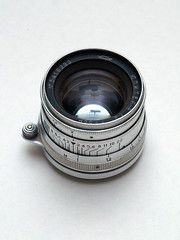(→Links) |
(→Links) Tags: Visual edit apiedit |
||
| Line 18: | Line 18: | ||
== Links == |
== Links == |
||
| + | * [http://www.sample-image.com/jupiter-8-50mm-f2/ Jupiter-8 50mm f/2 - Sample Images] at [http://www.sample-image.com/ www.sample-image.com/] |
||
* [http://blog.bkspicture.com/review_Jupiter_8_50mm_f2.html Jupiter-8 50mm f/2 (l39) Review by BKSPicture] |
* [http://blog.bkspicture.com/review_Jupiter_8_50mm_f2.html Jupiter-8 50mm f/2 (l39) Review by BKSPicture] |
||
* PGallery.net has a page of [http://www.pgallery.net/dingo/folder-3356.html images made with a Jupiter-8] |
* PGallery.net has a page of [http://www.pgallery.net/dingo/folder-3356.html images made with a Jupiter-8] |
||
Revision as of 18:06, 4 April 2015

|
| Jupiter-8 (M39 mount). (Image rights) |
The Jupiter-8 (sometimes marked in Cyrillic, ЮПИТЕР-8) is a postwar Soviet copy of the prewar Zeiss Sonnar 50mm f/2 for the Contax, built with six elements in three groups. It was made in Contax and M39 mounts, both for rangefinder cameras.
KMZ originally made the Jupiter-8 for Arsenal's Kiev (a copy of the Contax); it later produced a version in M39 mount for its Zorki rangefinder camera series. It first appeared on the Zorki 3 in 1953, and later was the standard lens on the Zorki 3S. GOMZ's Leningrad came with a KMZ-built Jupiter-8, but it is unclear whether they were custom built or the regular production model.
One of its weak points of this lens is the aluminium lens barrel, which is easily damaged if dropped. The filter thread on the front is particularly vulnerable, though there are some uncommon examples of this lens in a stainless-steel barrel, desirable for their durability. The lens takes 40.5mm filters. The aperture ring lacks click stops, so it is easy to accidentally change the setting. Click stops were introduced in Jupiter 8M version in Contax rangefinder mount.
Without a doubt the strength of the lens is the image quality. Soviet optical factories were known for sharp optics, and this one is no exception. The edges are not so good but the center is.
As with most Soviet products, many examples of this lens have minor defects or are put together poorly. Buying one of these lenses is a gamble. Still, these lenses are more reliable than the other Jupiter models, and the price is lower.
The lens was originally available only in the natural rather dull "silver" of aluminium but in the 1970s was also made with a black finish. It belonged to the Soviet class of lenses which was named Jupiter
Links
- Jupiter-8 50mm f/2 - Sample Images at www.sample-image.com/
- Jupiter-8 50mm f/2 (l39) Review by BKSPicture
- PGallery.net has a page of images made with a Jupiter-8
- A Jupiter-8 page at Alfred's Camera Page
- Flickr Smaller Jupiter-8 group